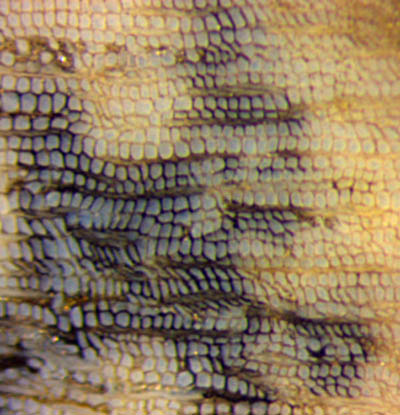Black fossil wood bleached
Well
preserved silicified wood with black aspect has repeatedly been
mistaken for fossil charcoal [1, 2, 3]. Since real fossil charcoal is of
scientific interest in palaeobotany [4], the subject is worth being
considered once more. One particular
sample, found in the Lower Permian Döhlen Basin in 1992 and declared
fossil charcoal by professionals, has provided several details
contradicting the charcoal interpretation, as explained in Fossil Wood
News 9,
35, 37, 38,
40.
 Polished faces of petrified wood may appear
dark or nearly black. A closer look shows that the dark aspect may be
due to dark or transparent fills within the cells. Less often the cell
walls are distinctly black, as in Fig.1 above the gap.
Polished faces of petrified wood may appear
dark or nearly black. A closer look shows that the dark aspect may be
due to dark or transparent fills within the cells. Less often the cell
walls are distinctly black, as in Fig.1 above the gap.
Large deformations of
tissue as in Fig.2 and Fossil
Wood News 40 are not compatible with charcoal. Pale spots in black tissue seem to indicate wood rather than
charcoal. 
Fig.1 (right): Black wood torn asunder while soft, silicified; progress
of bleaching from below stopped at gap. Image width 2mm.
Fig.2 (left): Black wood deformed while soft, silicified,
locally bleached; same sample. Image width 1mm.
Below the gap in Fig.1 the tissue is slightly
less black, with brown pith rays in between, hence some bleaching process
proceeding from below had ended at the gap. Probably the tissue was black throughout but became
pale brown locally, with depth of bleaching up to 10mm: Fig.2. These images and previous contributions
suggest a sequence of events as follows:
This sample does not serve as evidence of a
burning tree crushing
into the swamp, as
recently proposed [3]. It
is rather a fragment of a tree trunk which had lain in the swamp for
some time, turned
black there, was
locally deformed and torn into pieces of various size while still
soft, got silicified into hard chalcedony
(chert) together with
the swamp water filling wood cells and gaps, then broke into parts
which, lying in some Lower Permian sediment for an indefinite
time, became superficially bleached, eventually came out when
the strata of the Döhlen Basin were partially eroded, and
finally ended up in the top soil at Wilmsdorf, together with "common" fossil wood and
less common fossil tree ferns.
Sample: W/55, found in 1992 at Wilmsdorf, Döhlen Basin near Dresden, Saxony.
A question is left: What are the black
stains on the cell walls, if not
carbon from charcoal ? Possibly they are microbial coatings turned
black after the decay of the microbes, like those occasionally seen on
other fossil plants and fungi (Rhynie
Chert
News 83, 85, 104,
181), .
H.-J. Weiss
2022
[1] R. Rössler: Der versteinerte Wald von Chemnitz. Museum f. Naturkunde Chemnitz, 2001, 179.
[2] R. Noll, V. Wilde : Conifers from the „Uplands“ – Petrified wood from Central Germany,
in: U. Dernbach, W.D. Tidwell : Secrets of Petrified Plants, D'ORO Publ., 2002, 88-103.
[3] R. Rössler, Habilitation
lecture, Freiberg.
[4] A. Jasper, A. Pozzebon-Silva, J. Carniere, D. Uhl : Palaeozoic and Mesozoic palaeo-wildfires: An overview on advances ... (researchgate.net 2021)
 |

|
41 |


 Polished faces of petrified wood may appear
dark or nearly black. A closer look shows that the dark aspect may be
due to dark or transparent fills within the cells. Less often the cell
walls are distinctly black, as in Fig.1 above the gap.
Polished faces of petrified wood may appear
dark or nearly black. A closer look shows that the dark aspect may be
due to dark or transparent fills within the cells. Less often the cell
walls are distinctly black, as in Fig.1 above the gap.


